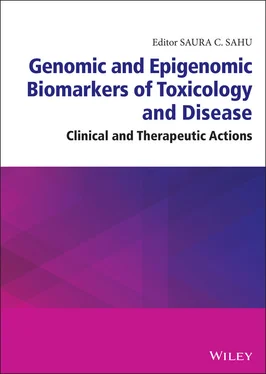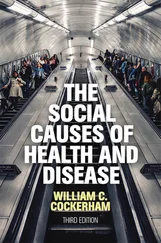Genomic and Epigenomic Biomarkers of Toxicology and Disease
Здесь есть возможность читать онлайн «Genomic and Epigenomic Biomarkers of Toxicology and Disease» — ознакомительный отрывок электронной книги совершенно бесплатно, а после прочтения отрывка купить полную версию. В некоторых случаях можно слушать аудио, скачать через торрент в формате fb2 и присутствует краткое содержание. Жанр: unrecognised, на английском языке. Описание произведения, (предисловие) а так же отзывы посетителей доступны на портале библиотеки ЛибКат.
- Название:Genomic and Epigenomic Biomarkers of Toxicology and Disease
- Автор:
- Жанр:
- Год:неизвестен
- ISBN:нет данных
- Рейтинг книги:4 / 5. Голосов: 1
-
Избранное:Добавить в избранное
- Отзывы:
-
Ваша оценка:
- 80
- 1
- 2
- 3
- 4
- 5
Genomic and Epigenomic Biomarkers of Toxicology and Disease: краткое содержание, описание и аннотация
Предлагаем к чтению аннотацию, описание, краткое содержание или предисловие (зависит от того, что написал сам автор книги «Genomic and Epigenomic Biomarkers of Toxicology and Disease»). Если вы не нашли необходимую информацию о книге — напишите в комментариях, мы постараемся отыскать её.
The latest developments in biomarker research applicable to toxicology and medicine Genomic and Epigenomic Biomarkers of Toxicology and Disease: Clinical and Therapeutic Actions
Genomic and Epigenomic Biomarkers of Toxicology and Disease: Clinical and Therapeutic Actions
Genomic and Epigenomic Biomarkers of Toxicology and Disease — читать онлайн ознакомительный отрывок
Ниже представлен текст книги, разбитый по страницам. Система сохранения места последней прочитанной страницы, позволяет с удобством читать онлайн бесплатно книгу «Genomic and Epigenomic Biomarkers of Toxicology and Disease», без необходимости каждый раз заново искать на чём Вы остановились. Поставьте закладку, и сможете в любой момент перейти на страницу, на которой закончили чтение.
Интервал:
Закладка:
The epigenome is defined as heritable biological information contained outside the DNA sequence (Dolinoy and Jirtle 2008). It consists of DNA methylation, histone modifications, and microRNAs. Non-coding RNAs (ncRNAs) regulate gene expression at the transcriptional or post-translational levels without changing the genomic DNA sequence (Li and Cui 2018).
MicroRNAs
The microRNAs form a class of single-stranded, non-coding small RNAs with an average of 22 nucleotides. They are involved in the post-transcriptional regulation of gene expression. They were discovered in 1993 by the Victor Ambros research group (Lee et al. 1993), in a study on the development of Caenorhabditis elegans . These researchers discovered that the microRNA lin-4 regulated negatively the expression of another gene, lin-14. In subsequent studies, microRNAs were identified in multiple species, including plants, worms, insects, fish, rodents, and mammals. The sequences of microRNAs in mammalian species are highly conserved (Friedman et al. 2009). The microRNAs are found in body fluids such as saliva, urine, and plasma. Schueller et al. (2018) have demonstrated that the dysregulation of microRNAs is associated with toxicity and liver diseases. The microRNAs are considered new molecules related to disease classification and prediction (Otsuka et al. 2017) and can be used as a biomarker in the prediction of liver cancer (Livingstone et al. 2019). Changes in microRNA expression after chemical exposure can be determined by microarrays and next-generation sequencing technologies. It is believed that microRNA profiling is a valuable diagnostic tool. The microRNAs can serve as excellent biomarkers of toxicity and disease.
Differentially expressed microRNAs are the most common genomic biomarkers used for drug safety. Candidates for translational microRNA biomarkers for liver injury have been proposed (Li et al. 2021). Urinary microRNA biomarkers of drug-induced kidney injury have been suggested (Chorley et al. 2021). Recent studies have provided evidence that tumor-related genes regulated through DNA methylation and microRNA are involved in the occurrence of hepatocellular carcinoma (Lin et al. 2019).
Circular RNAs
Circular RNAs (circRNAs) are a class of closed, long, non-coding RNAs with stable expression in various tissues in different mammalian species. These most recently discovered ncRNAs are present abundantly in the transcriptome of eukaryotic cells. They play an important role in the regulation of gene expression (Shao and Jiang 2021) and in tumor development (Jeyaraman et al. 2019). Therefore they are considered potential biomarkers of toxicity and disease (Jeyaraman et al. 2019; Shao and Jiang 2021).
The Need for a Book on Genomic and Epigenomic Biomarkers for Predictive Toxicity and Disease
The rate of publications during the last few years has demonstrated that the developments of genomic and epigenomic biomarkers for predictive toxicity and disease are moving very rapidly, and therefore there is a need for new means to report the updated current status of this new area of research. As editor of Genomic and Epigenomic Biomarkers for Toxicology and Disease: Clinical and Therapeutic Actions , it gives me great pride, pleasure, and honor to introduce this unique book, which encompasses many aspects of genomic and epigenomic biomarker research never brought together in one publication before.
References
1 Califf, R.M. (2018). Biomarker definitions and their applications. Exp. Biol. Med. (Maywood) 243 (3): 213–221. Published online 2018 Feb 6. https://doi.org/10.1177/1535370217750088.
2 Chorley, B.N., Ellinger-Ziegelbauer, H., Tackett, M., Simutis, F.J., Harrill, A.H., McDuffie, J., Atabakhsh, E., Nassirpour, R., Whiteley, L.O., Léonard, J., Carswell, G.K., Harpur, E., Chen, C.L., and Gautier, J. (2021). Urinary miRNA biomarkers of drug-induced kidney injury and their site specificity within the nephron. Toxicol. Sci. 180 (1): 1–16. https://doi.org/10.1093/toxsci/kfaa181.
3 de Gannes, M., Ko, C., Zhang, X., Biesiada, J., Niu, L., Koch, S.E., Medvedovic, M., Rubinstein, J., and Puga, A. (2020). Dioxin disrupts dynamic DNA methylation patterns in genes that govern cardiomyocyte maturation. Toxicol. Sci. 178 (2): 325–337. https://doi.org/10.1093/toxsci/kfaa153.
4 Dolinoy, D.C. and Jirtle, R.L. (2008). Environmantal epigenomics in human health and disease. Environ. Mol. Mutagen. 49 (1): 4–8.
5 Friedman, R.C., Farh, K.K., Burge, C.B., and Bartel, D.P. (2009). Most mammalian mRNAs are conserved targets of microRNAs. Genom. Res. 19: 92–105.
6 Jeyaraman, S., Hanif, E.A.M., Ab Mutalib, N.S., Jamal, R., and Abu, N. (2019). Circular RNAs: Potential regulators of treatment resistance in human cancers. Front. Genet. 10: 1369.
7 Jones, P.A. (2012). Functions of DNA methylation: Islands, start sites, gene bodies and beyond. Nat. Rev. Genet. 13: 484–492.
8 Judson, R., Houck, K., Martin, M., Richard, A.M., Knudsen, T.B., Shah, I., Little, S., Wambaugh, J., Setzer, R.W., Kothya, P., Phuong, J., File, D., Smith, D., Reif, D., Rotroff, D., Kleinstreuer, N., Sipes, N., Xia, M., Huang∣, R., Crofton, K., and Thomas, R.S. (2016). Analysis of the effects of cell stress and cytotoxicity on in vitro assay activity across a diverse chemical and assay space. Toxicol. Sci. 152 (2): 323–339.
9 Judson, R., Kavlock, R., Martin, M., Reif, D., Houck, K., Knudsen, T., Richard, A., Tice, R.R., Whelan, M., Xia, M., Huang, R., Austin, C., Daston, G., Hartung, T., Fowle, J.R., Wooge, W., Tong, W., and Dix, D. (2013). Perspectives on validation of high-throughput assays supporting 21st century toxicity testing. ALTEX 30 (1): 51–56.
10 Krewski, D., Acosta, D., Andersen, M., Anderson, H., Bailar, J.C., Boekelheide, K., Brent, R., Charnley, G., Cheung, V.G., Green, S., Kelsey, K.T., Kerkvliet, N.I., Li, A.A., McCray, L., Meyer, O., Patterson, R.D., Pennie, W., Scala, R.A., Solomon, G.M., Stephens, M., Yager, J., and Zeise, L. (2010). Toxicity testing in the 21st century: A vision and a strategy. J. Toxicol. Environ. Health. B. Crit. Rev. 2010 Feb 13 (0): 51–138. 10.1080/10937404.2010.483176.
11 Lee, R.C., Feinbaum, R.L., and Ambros, V. (1993). The C. elegans heterochronic gene lin-4 encodes small RNAs with antisense complementarity to lin-14. Cell 75: 843–854.
12 Li, C.Y. and Cui, J.Y. (2018). Regulation of protein-coding gene and long noncoding RNA pairs in liver of conventional and germ-free mice following oral PBDE exposure. Plos One 13: e0201387.
13 Li, D., Knox, B., Gong, B., Chen, S., Guo, L., Liu, Z., Tong, W., and Ning, B. (2021). Identification of translational microRNA biomarker candidates for ketoconazole-induced liver injury using next-generation sequencing. Toxicol. Sci. 179 (1): 31–43. https://doi.org/10.1093/toxsci/kfaa162.
14 Lin, C., Yuan, G., Hu, Z., Zeng, Y., Qiu, X., Yu, H., and He, S. (2019). Bioinformatics analysis of the interactions among lncRNA, miRNA and mRNA expression, genetic mutations and epigenetic modifications in hepatocellular carcinoma. Mol. Med. Rep. 19: 1356–1364. https://doi.org/10.3892/mmr.2018.9728.
15 Livingstone, M.C., Johnson, N.M., Roebuck, B.D., Kensler, T.W., and Groopman, J.D. (2019). Serum miR-182 is a predictive biomarker for dichotomization of risk of hepatocellular carcinoma in rats. Mol. Carcinog. 58: 2017–2025. https://doi.org/10.1002/mc.23093.
16 NAS (U.S. National Academy of Sciences). (2007). Toxicity Testing in the 21st Century: A Vision and A Strategy. Washington, DC: National Academy Press.
17 Otsuka, M., Kishikawa, T., Yoshikawa, T., Yamagami, M., Ohno, M., Takata, A., Shibata, C., Ishibashi, R., and Koike, K. (2017). MicroRNAs and liver disease. J. Hum. Genet. 62: 75–80. https://doi.org/10.1038/jhg.2016.53.
Читать дальшеИнтервал:
Закладка:
Похожие книги на «Genomic and Epigenomic Biomarkers of Toxicology and Disease»
Представляем Вашему вниманию похожие книги на «Genomic and Epigenomic Biomarkers of Toxicology and Disease» списком для выбора. Мы отобрали схожую по названию и смыслу литературу в надежде предоставить читателям больше вариантов отыскать новые, интересные, ещё непрочитанные произведения.
Обсуждение, отзывы о книге «Genomic and Epigenomic Biomarkers of Toxicology and Disease» и просто собственные мнения читателей. Оставьте ваши комментарии, напишите, что Вы думаете о произведении, его смысле или главных героях. Укажите что конкретно понравилось, а что нет, и почему Вы так считаете.












![John Bruce - The Lettsomian Lectures on Diseases and Disorders of the Heart and Arteries in Middle and Advanced Life [1900-1901]](/books/749387/john-bruce-the-lettsomian-lectures-on-diseases-and-disorders-of-the-heart-and-arteries-in-middle-and-advanced-life-1900-1901-thumb.webp)